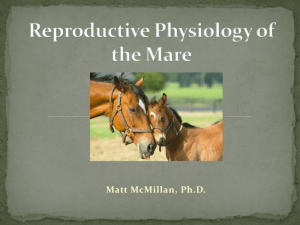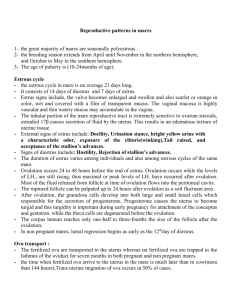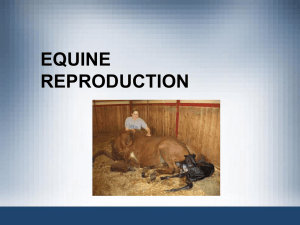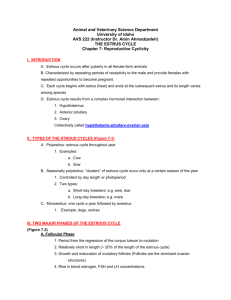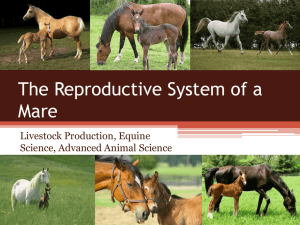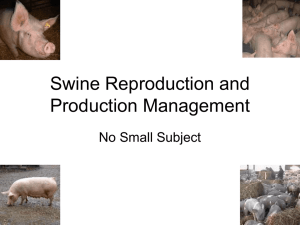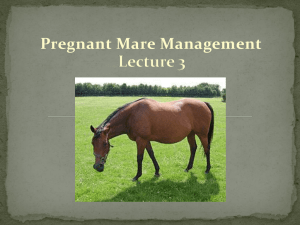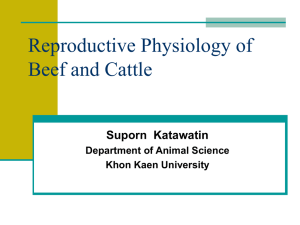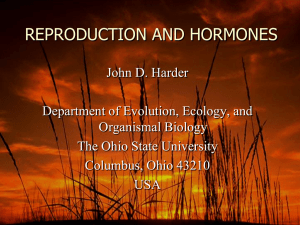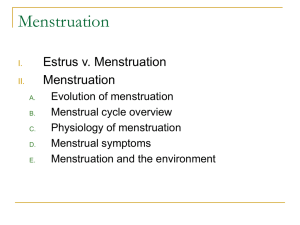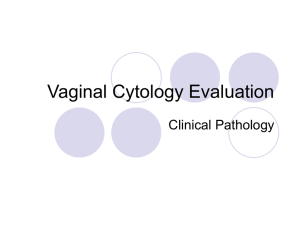estrous cycle of mare - An-Najah Staff - An
advertisement
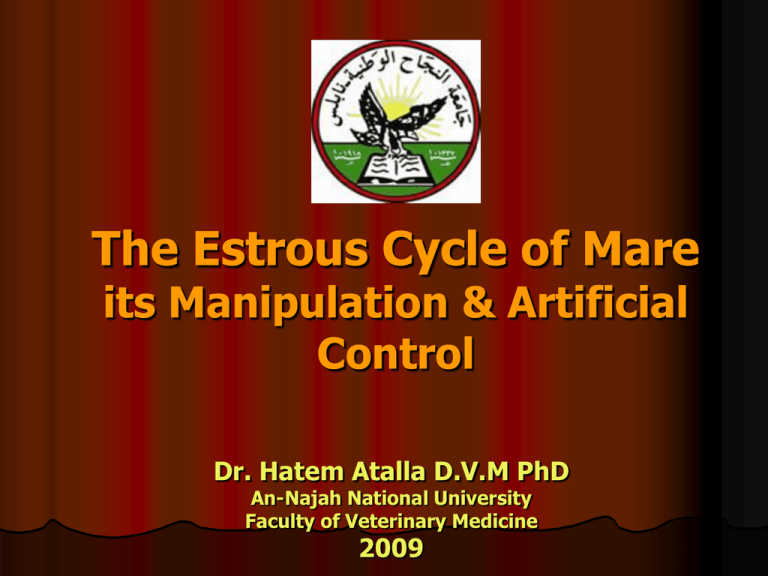
The Estrous Cycle of Mare its Manipulation & Artificial Control Dr. Hatem Atalla D.V.M PhD An-Najah National University Faculty of Veterinary Medicine 2009 Seasonality Their season is initiated as the ratio of daylight to darkness increases and ends during decreasing day lengths. The average season for horses, extending from February(2) to November(11). Peak fertility is obtained if mares are bred between May(5) and July(7). Behavioral estrus occurring during short-day months (January to April) is frequently not accompained by ovulation. Seasonality The physiologic (natural) breeding season of the mare occurs in late spring and summer. During the Transition from anestrus to physiologic polyestrus, the mare will frequently have variable length periods of behavioral signs of estrus without developing follicular structures or ovulating. J F M Neuropathway A M J J A Receptors in eye S O N D Neuropathway Decreasing melatonin Pineal gland Increasing melatonin Increasing GnRH Hypothalamus Decreasing GnRH Increasing Gonadotropins (FSH, LH) Anterior pituitary Ovaries Decreasing gonadotropins Anestrus Anestrus is caused by the secretion of melatonin, which is secreted in response to increasing darkness. The melatonin inhibits GnRH, so the FSH and LH are low. Anestrus occurs around Winter solstice. About 80% of mares undergo anestrus. Mares in anestrus are passive to the stallion advances. On rectal palpation the ovaries are small, smooth, and inactive. The cervix and uterus are flaccid. Vaginoscopic exam reveals a cervix that is pale and dry, and the cervix may even be open. The hormones are all at very low concentrations. If the is nutrition poor, the mare may not cycle back in the spring. Spring transition The increasing daylight length in the spring brings about a series of changes in the mare. Decrease of Melatonin secretion As the melatonin decreases, GnRH resumes secretion, and FSH and LH also increase. With increased FSH, follicles start to grow. Most of these follicles are not steroidogenically competent so they do not produce estrogen. They also do not ovulate. In fact, an average of 3.7 waves of follicular development occur before the first ovulation. After several waves, an estrogen producing follicle finally develops and ovulates. The first ovulation of the season, on the average, occurs about April 8 Physiological Breeding Season 21 day inter-ovulatory interval (estrous cycle) Estrus (heat): 5 – 7 days Ovulation: Diestrus: 24 to 48 hours prior to end of heat 14 – 16 days Fall transition Fall transition mirrors spring transition. You see: prolonged heats, irregular cycles, large 'hung' or 'autumn' anovulatory follicles. These follicle become atretic and the mare goes into anestrus. This is caused from the low LH release because melatonin is taking its grip again as the day length decreases. There is no treatment for fall transition. Estrous Cycle of the Mare Endocrinology of the Estrous Cycle Mating Behavior (Estrus signs) The mare will allow the stallion to smell and bite. She will extend her hind legs, lift her tail to the side and lower her rump. The erect clitoris will be exposed frequently by contractions (winking) of the labia. The vulva will be elongate and swollen, with the labia partly everted. The mare should be teased by a stallion for accurate detection. Attempts to fight the stallion indicate she is not in estrus even though some other signs of estrus are apparent. Timing of Insemination “Mares” Best results without palpation are obtained by multiple breedings starting on the third day and repeating at 48-hours intervals until the mare is no longer in estrus. When only one breeding is desired it is recommended that the mare be palpated and bred when she has a 35mm follicle. She should be palpated 2 days later to see if ovulation occurred and if not, she should be rebred. When two large follicles are detected by palpation, mares should not be bred, since pregnancies involving twins are usually terminated by abortion. Some breeders inject LH at the time of breeding to insure ovulation while sperm are viable. Foal Heat Mares will come into estrus from 7 to 12 days after parturition (foaling heat) and can frequently be bred with good results. However, mares should be bred at this time only if they have been given a careful examination to determine if there has been adequate recovery since parturition. If there is any question about recovery, wait until the next estrus, which will occur about 30 days postpartum. Criteria Mares Should Meet In Order to Be Bred During Foal Heat Delivery of foal without significant difficulty. Pass placenta within 3 hrs after birth A healthy foal that stands and nurses within 1 hr. A cervix free from bruises and abnormal discharges. A uterus significantly reduced in size, without fluid accumulations. Estrus Manipulation Methods Artificial lighting Shortening Late Transition Inducing Ovulation Estrus synchronization Estrus Synchronization & Ovulation Induction Manipulation Methods: Light Light can be supplemented in the afternoon and evening to give a total of 16 hours light each day. Aged mares (greater than 10 1. 200 watts for a 12 x 12 yrs) take ~12-18 days longer Stall X 60 days, start Dec 1 No advantage to starting 2. 20 watts, 12 x 12 Stall X before Dec 1 75 days Hormone Management - Progestagens Regumate Oral Suppresses estrus by forming an artificial luteal period. Dose - 1 ml/50 kg orally or in feed for 14 days. Heat occurs 4-5 days after withdraw Injectable progesterone Estrus suppression 100 mg/day prevents estrus and ovulation. Progesterone or related compounds Regumate – most common Normalization of estrus Regulation of estrus Estrus synchronization Long-term suppression of estrus Delay foal heat Pregnancy maintenance PGF2 Lutalayse or Estrumate Shorten the interval between estrous periods Treatment of a maintained corpus luteum After foal heat Estrous synchronization with prostaglandins Hormone Management Prostglandins Only works on mature corpus Lutalyse luteum (~ 5 d after ovulation) Dose is 5-10 mg (1-2 cc/mare) Mare will come into heat 2-5 IM. days later. Side effects Ovulation in 8 - 9 days Estrumate The time to estrus varies Dose is 200 mcg/mare IM. depending on follicular Fewer side effects development on the ovary. Side effects can be sever in mare Sweating Abdominal cramps, increased motility of GI tract and/or colic Increased heart rate Muscle weakness and balance problems All side effects begin at 5 - 10 minutes and last until 60 minutes after injection Induction of Ovulation hCG Dose 1,500-3,000 IU IV 3.5 cm follicle Ovulation normally occurs within 36-48 hours. 80% of mares will ovulate within 48 hr Older Mares loose 13-15 % More you use it, the less effective it becomes on subsequent heats 10% less effective Feb, Mar, Apr Deslorelin 3.5 cm follicle, ovulate 36-48 hrs, 90% As effective as hCG without antibodies Estrogen Limited use: “Induction of estrus” for jump mare Estradiol cypionate; 5-10 mg Start 3-4 days prior to wanting mare showing signs of estrus “Enhance Estradiol signs of estrus” in silent heats 17B; 1-2 mg Suppress Estrous Sterile, 30 to 35 mm diameter glass marble into the uterus within 24 hrs after ovulation Increases the interovulatory interval from 21 days to ~ 90 days for about 40 to 70% of mares Appears to be no discomfort, nor any detrimental effects on future breeding prospects
